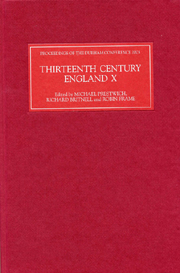Book contents
- Frontmatter
- Contents
- PREFACE
- ABBREVIATIONS
- The Meetings of Kings Henry III and Louis IX
- Counting the Cost: The Financial Implications of the Loss of Normandy
- Networks of Markets and Networks of Patronage in Thirteenth-Century England
- Three Alien Royal Stewards in Thirteenth-Century England: The Careers and Legacy of Mathias Bezill, Imbert Pugeys and Peter de Champvent
- The Eyre de terris datis, 1267–1272
- Joan, Wife of Llywelyn the Great
- Town and Crown: The Kings of England and their City of Dublin
- English Landholding in Ireland
- The Reception of the Matter of Britain in Thirteenth-Century England: A Study of Some Anglo-Norman Manuscripts of Wace's Roman de Brut
- Fearing God, Honouring the King: The Episcopate of Robert de Chaury, Bishop of Carlisle, 1258–1278
- Cloistered Women and Male Authority: Power and Authority in Yorkshire Nunneries in the Later Middle Ages
- Taxation and Settlement in Medieval Devon
- Clipstone Peel: Fortification and Politics from Bannockburn to the Treaty of Leake, 1314–1318
- Royal Patronage and Political Allegiance: The Household Knights of Edward II, 1314–1321
- ‘Edward II’ in Italy: English and Welsh Political Exiles and Fugitives in Continental Europe, 1322–1364
Clipstone Peel: Fortification and Politics from Bannockburn to the Treaty of Leake, 1314–1318
Published online by Cambridge University Press: 12 September 2012
- Frontmatter
- Contents
- PREFACE
- ABBREVIATIONS
- The Meetings of Kings Henry III and Louis IX
- Counting the Cost: The Financial Implications of the Loss of Normandy
- Networks of Markets and Networks of Patronage in Thirteenth-Century England
- Three Alien Royal Stewards in Thirteenth-Century England: The Careers and Legacy of Mathias Bezill, Imbert Pugeys and Peter de Champvent
- The Eyre de terris datis, 1267–1272
- Joan, Wife of Llywelyn the Great
- Town and Crown: The Kings of England and their City of Dublin
- English Landholding in Ireland
- The Reception of the Matter of Britain in Thirteenth-Century England: A Study of Some Anglo-Norman Manuscripts of Wace's Roman de Brut
- Fearing God, Honouring the King: The Episcopate of Robert de Chaury, Bishop of Carlisle, 1258–1278
- Cloistered Women and Male Authority: Power and Authority in Yorkshire Nunneries in the Later Middle Ages
- Taxation and Settlement in Medieval Devon
- Clipstone Peel: Fortification and Politics from Bannockburn to the Treaty of Leake, 1314–1318
- Royal Patronage and Political Allegiance: The Household Knights of Edward II, 1314–1321
- ‘Edward II’ in Italy: English and Welsh Political Exiles and Fugitives in Continental Europe, 1322–1364
Summary
Defensive structures called ‘peels’ are mentioned quite frequently in early fourteenth-century sources, in England, in connection with the building of castles in Wales after the conquest, and in the Scottish wars, when they were mostly used to strengthen major castles. The Anglo-Norman French word pel means a stake, and seems to have been extended to describe fortifications in which palisades made up of stakes were a major component. It is certain that wood played the major part in their construction, and the one moved from Newcastle to Roxburgh in 1334, for example, was apparently made entirely of wood. The more varied composition of some peels is well illustrated by the one built at Frethun near Calais in 1351–2 by a master mason and a master carpenter, indicating a mixture of stone and wood. Peels built at English castles included one at Nottingham, ordered in 1312 to be built in haste at the castle on the west side towards Lenton, which was of stone. On the other hand, the peel at Hanley castle in Worcestershire, built in 1324, appears to have been only a wooden stockade round a ditch.
Although most peels in England in the reign of Edward II were subsidiary parts of or close to castles, a few were evidently free-standing. Several were built in the north in the years immediately after the battle of Bannockburn, at the same time as some existing northern castles were strengthened, evidently for defence against the Scots. The clearest example was at Staward in Northumberland, halfway between Newcastle and Carlisle, built mostly of wood.
- Type
- Chapter
- Information
- Thirteenth Century England XProceedings of the Durham Conference, 2003, pp. 187 - 196Publisher: Boydell & BrewerPrint publication year: 2005

